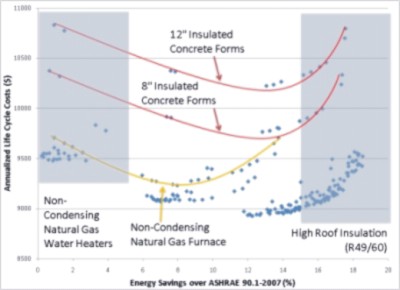
Every new version of LEED® uses an updated energy code, and that means you need to work harder to get those precious energy and atmosphere credits. But it’s no longer just a matter of slapping an extra layer of insulation on your roof, because you’re probably just wasting your money.
BEopt is a design tool, aimed primarily at residential design, that I’ve tweaked for small office analysis because it uses the powerful simulation engine that we use on a regular basis. It estimates life cycle cost and shows how to get the most energy efficiency for the lowest life cycle cost. Here are some things I’ve found using BEopt on this project:

1. Insulated concrete forms (ICF) may not be cost effective.
ICFs are being touted as the next big thing. But let’s forget about the loads of carbon produced when manufacturing concrete for a moment. This energy simulation modeled a 13,000 square foot office space in Iowa and used RSMean’s costs to estimate several wall life cycle costs (LCC). In this case, insulated concrete forms still cost 10-20% more (LCC) despite being the only wall modeled with lower infiltration[1]. They save about 10% of the building energy (primarily through air sealing), but, in this case, the reduction in energy costs doesn’t offset the increase in construction costs. Don’t forget, there are other ways to air seal a building.
2. Extra roof insulation is a waste.
Insulation suffers from diminishing returns on investment. Think about insulation like the screen on your front door. A one-inch wire mesh might keep the neighbor’s dog out, but won’t do much about flies. An 8 mesh (8 divisions per inch in both directions) should keep flies out, but if you also want mosquitoes out, you’ll need something closer to a 20 mesh. Now, you could install a more refined mesh than that, but it’s not going to do you much good because you’ve already stopped most of the problem. If you want cleaner air, buy an air purifier because there are other sources of stuff floating around. Similarly, once you’ve met the code for roof insulation, there are better uses for your money if you want to save more energy.
3. Condensing heaters are a no-brainer in heating climates.
High efficiency boilers and furnaces are past the tipping point in heating climates. Even if you’re only going to be in the building for 5 years (why bother building?), a 92.5 AFUE furnace still (barely) pays for itself. And our analysis doesn’t even account for the fact that sealed combustion units don’t need fire rated rooms (that cost more). If you’re not in a heating dominated climate, a condensing domestic water heater will still pay for itself quickly!
So what does this mean? In short, some things you might not need to think about, but realistically, more advanced design tools can help you save money and get more LEED points. But keep in mind, every situation is different, so what’s cost effective here might not work for you!
[1] Insulated concrete forms were modeled with typical air changes per hour (ACH) of 0.17 compared to the rest at 0.46 ACH.




